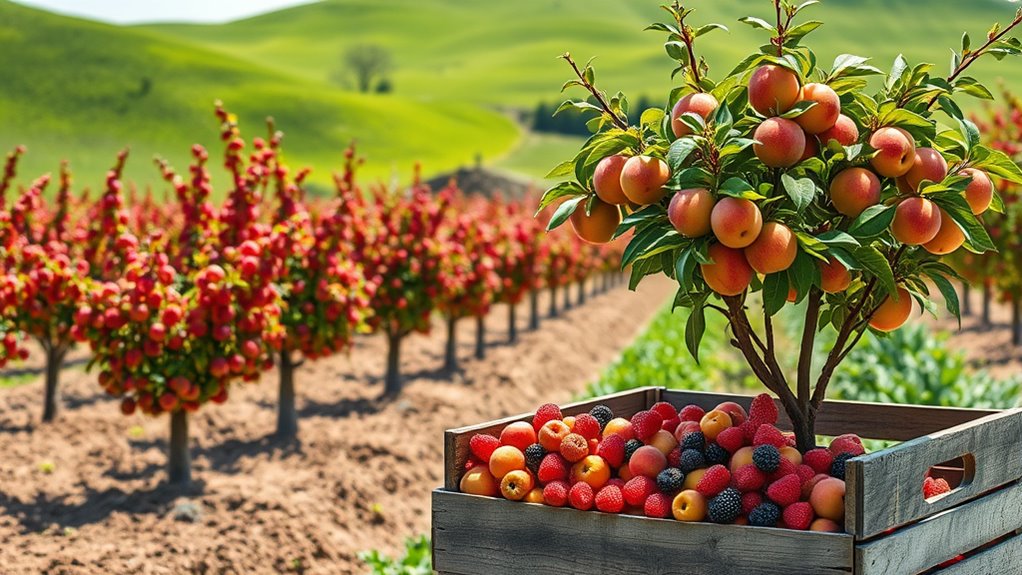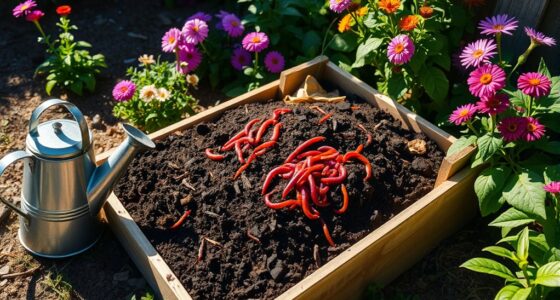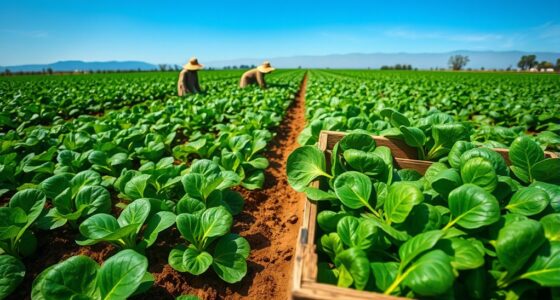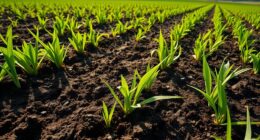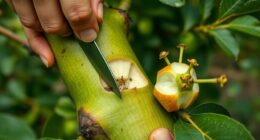For small farms, compact fruit trees like dwarf and semi-dwarf varieties are your best bet. They thrive in limited spaces and yield fruit quickly. Varieties such as Honeycrisp apples and Elberta peaches reach 6-10 feet and produce in just a few years. Plus, many are self-pollinating, which makes planting easier. With proper care and companion planting, you'll enjoy continuous harvests throughout the season. There's more to explore for maximizing your fruit yields!
Key Takeaways
- Dwarf and semi-dwarf fruit trees, like Honeycrisp apples and Elberta peaches, are ideal for maximizing space and yield on small farms.
- Self-pollinating varieties reduce the need for multiple trees, enhancing fruit production and simplifying planting arrangements.
- Implementing a triangular planting pattern improves sunlight exposure and airflow, promoting healthier tree growth.
- Regular pruning and well-drained soil are essential for maintaining tree size and boosting fruit yield.
- Companion planting with nitrogen-fixing and pest-repelling plants enhances soil health and protects fruit trees from pests.
Benefits of Compact Fruit Trees for Small Farms
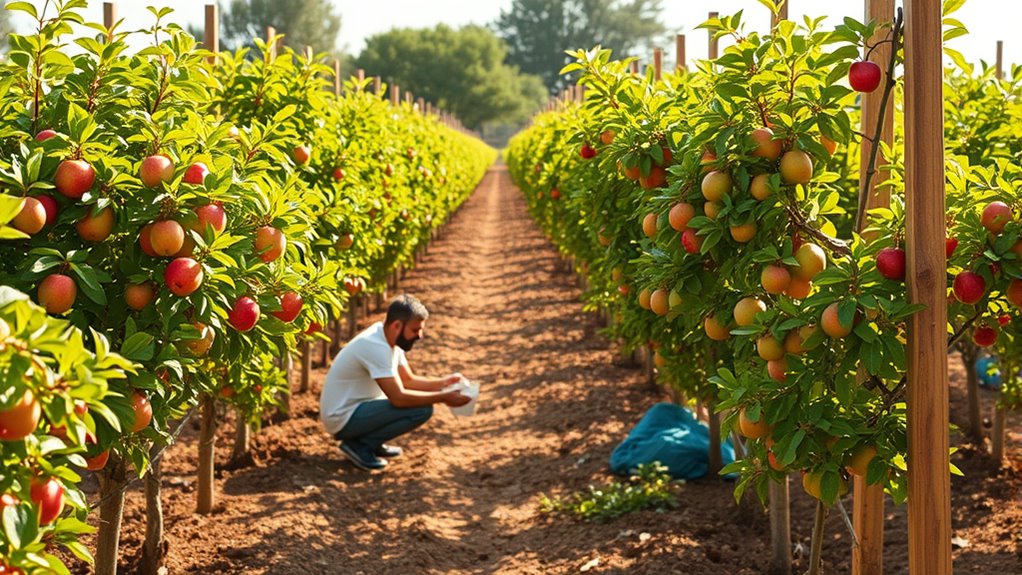
When you're working with limited space on a small farm, compact fruit trees offer a fantastic solution for maximizing your harvest.
Dwarf fruit trees and semi-dwarf varieties typically reach heights of 6-10 feet, making them easy to grow and maintain. You'll appreciate that these compact trees can bear fruit sooner—within just 2-3 years—compared to standard trees, which may take 6-9 years.
This quicker return on investment is perfect for small gardens. Additionally, planting self-pollinating varieties means you can optimize fruit production even with fewer trees.
Arranging your compact trees in guilds using a triangular layout enhances sunlight exposure and airflow, further boosting your orchard's productivity.
Embrace the benefits of compact fruit trees to maximize your farming success!
Ideal Dwarf and Semi-Dwarf Varieties
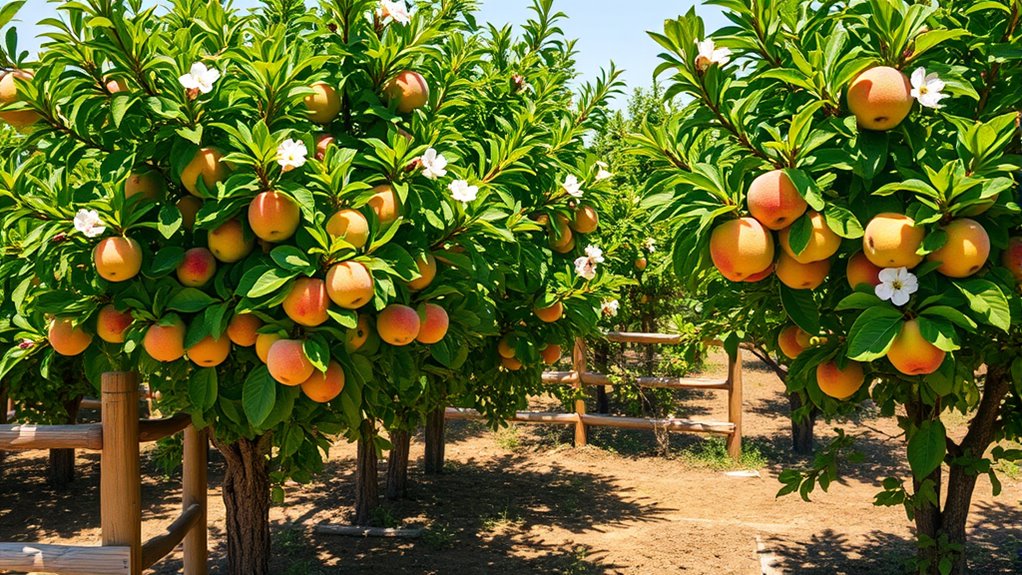
When choosing fruit trees for your small farm, consider the benefits of dwarf and semi-dwarf varieties.
These trees not only fit well in limited spaces but also provide abundant fruit with proper care.
Let's explore the top dwarf options, the best semi-dwarf choices, and what you need to know about pollination and spacing.
Top Dwarf Varieties
If you're looking to maximize fruit production on a small farm, consider incorporating top dwarf and semi-dwarf varieties into your planting scheme.
Dwarf apple trees, like Honeycrisp and Golden Delicious, reach only 6-8 feet tall and produce full-sized fruit within 2-3 years. Semi-dwarf peach trees, such as Elberta and Redhaven, grow to about 10-12 feet while yielding sweet, juicy fruit.
Dwarf cherry varieties, including Bing and Montmorency, are self-pollinating and thrive in limited spaces. Additionally, dwarf pear trees like Shinseiki and Clapps Favorite offer juicy, sweet pears, also self-pollinating.
With these options, you can guarantee high yields and delightful flavors, making them ideal for your small farm's fruit production.
Best Semi-Dwarf Options
Although space may be limited on your small farm, you can still enjoy a bountiful harvest by selecting the best semi-dwarf fruit tree varieties.
Consider semi-dwarf peach trees like Elberta and Redhaven, which grow to 10-15 feet and yield fruit in just 3-4 years. For a compact option, semi-dwarf plum trees such as Stanley reach 12-15 feet and require only 2-3 trees for cross-pollination.
If you're interested in cherry trees, dwarf varieties like Montmorency stay under 8 feet tall, producing sweet, tart cherries. Additionally, dwarf pear trees like Shinseiki are self-pollinating and reach about 6-8 feet, offering reliable yields.
With these fruit tree options, you'll maximize your harvest without sacrificing space.
Pollination and Spacing Needs
To guarantee a fruitful harvest, understanding the pollination and spacing needs of your dwarf and semi-dwarf fruit trees is vital. Dwarf varieties typically reach heights of 6-8 feet, while semi-dwarfs grow to 10-15 feet, making them perfect for small farms.
Many dwarf trees, like certain apple and cherry varieties, are self-pollinating, simplifying your planting arrangements. However, for non-self-pollinating trees such as most plums and cherries, plant at least two trees of the same species within 15-20 feet to assure proper cross-pollination.
Opt for a triangular planting pattern to maximize sunlight and airflow. Additionally, regular pruning is essential, as it maintains compact size and improves air circulation, enhancing pollination and overall tree health.
Essential Care and Maintenance Tips
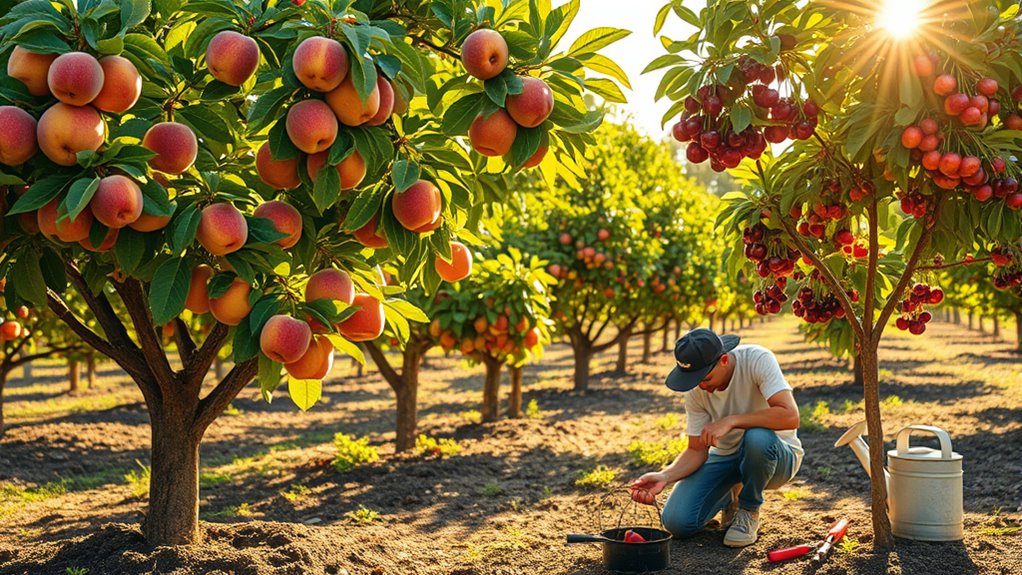
Proper care and maintenance of fruit trees is essential for maximizing yield and guaranteeing healthy growth, especially on small farms. Here are some key tips to keep in mind:
Effective care and maintenance of fruit trees is crucial for optimal yield and vibrant growth, especially on small farms.
- Pruning is important for maintaining tree size and promoting air circulation.
- Guarantee well-drained soil and establish proper watering systems to prevent waterlogging.
- Tailor your fertilization schedule to the specific fruit tree varieties you're growing.
Regular seasonal checks are crucial for early detection of diseases and deficiencies. Additionally, ensure that you monitor for wildlife encounters that may damage your trees, as understanding local fauna can help prevent conflicts.
By implementing these practices, you'll not only enhance growth but also boost fruit yield.
Pollination Considerations for Fruit Trees

When it comes to growing fruit trees, understanding pollination is key to achieving a bountiful harvest. Some trees, like sweet cherries, require cross-pollination from compatible varieties, so you'll need to plant at least two.
Self-pollinating fruit trees, such as apricots and nectarines, can thrive alone, making them perfect for small farms. Pay attention to pollination timing; trees need to bloom simultaneously for effective cross-pollination.
Also, creating a pollinator-friendly environment with flowers and habitats can greatly enhance your fruit production. Consider planting certain apple and pear varieties in groups, as this improves pollination efficiency and boosts fruit quality.
With the right approach, you'll enjoy a fruitful season!
Soil and Planting Requirements
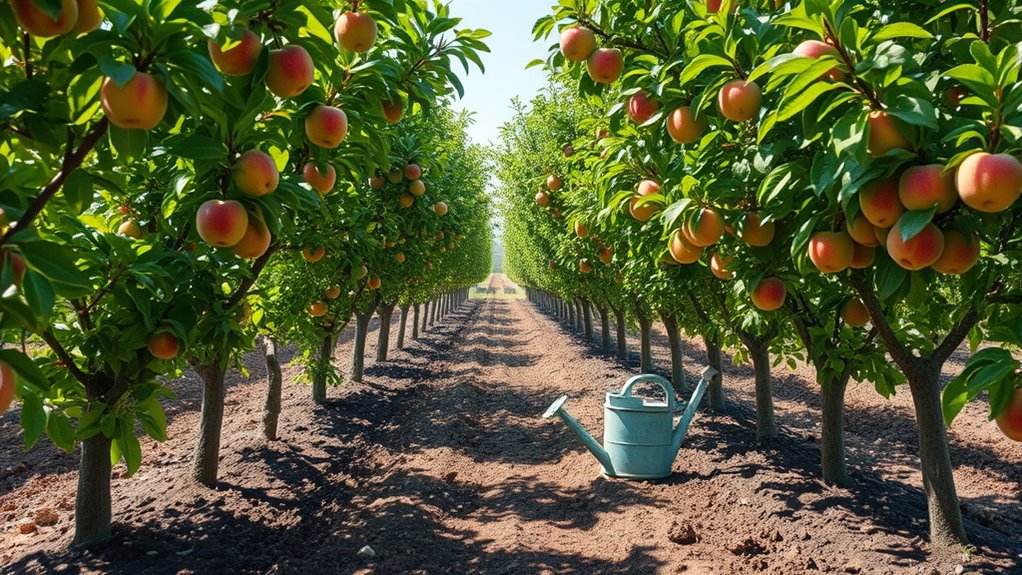
Successful fruit tree cultivation hinges on understanding soil and planting requirements. To set your trees up for success, consider these key factors:
- Soil Type: Use well-drained soil with a pH of 6.0 to 7.0.
- Planting Mix: Combine native soil with organic compost for enhanced fertility.
- Watering Needs: Monitor soil moisture to guarantee consistent watering, especially during dry spells.
Spacing is essential; dwarf trees should be placed 10-12 feet apart, while standard trees need 15-20 feet for proper sunlight and airflow.
Before planting, test the soil to identify any nutrient deficiencies, allowing you to amend it accordingly.
Maximizing Space With Vertical and Espalier Techniques
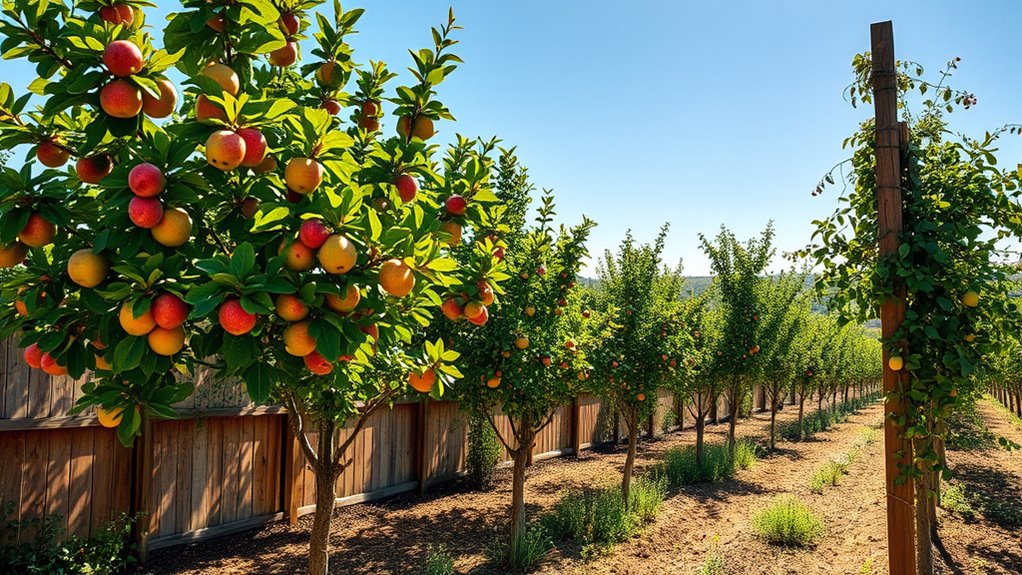
After setting up the right soil and planting conditions, you can further enhance your fruit tree cultivation by maximizing the limited space available on your small farm.
Utilizing vertical gardening techniques, like columnar fruit trees, allows for efficient fruit production along the trunk. Espalier techniques enable you to train trees to grow flat against walls, optimizing sunlight exposure and airflow while minimizing their footprint.
Dwarf fruit trees, reaching heights of 6-10 feet, are perfect for these methods, allowing you to cultivate fruit without sacrificing yield size. Regular pruning keeps their compact size and shape manageable.
Additionally, incorporating companion planting with flowering herbs beneath these trees enhances pollination and deters pests, creating a thriving ecosystem in your limited area.
Seasonal Harvesting and Extended Production
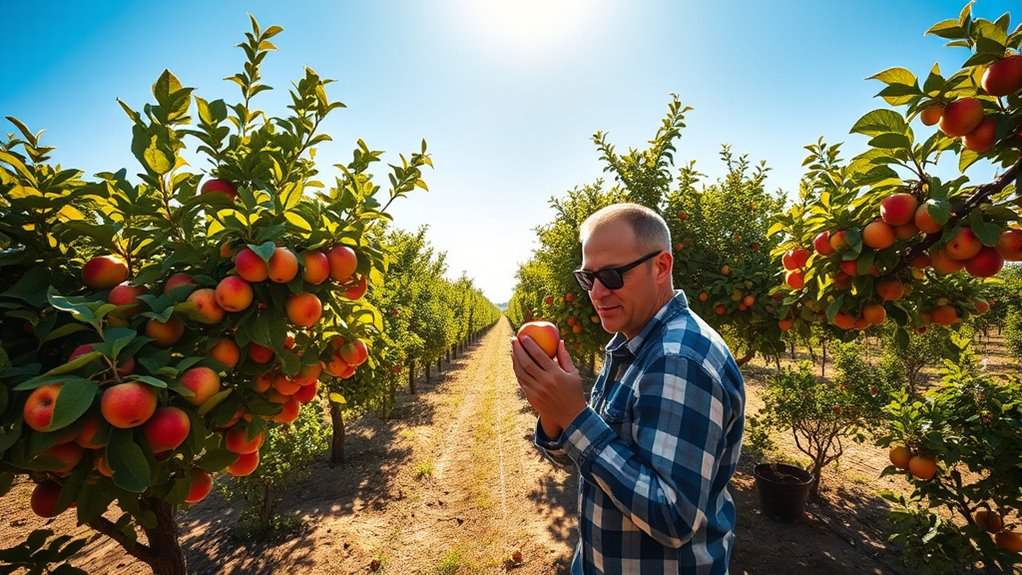
To maximize your harvest, choose fruit tree varieties that ripen at different times throughout the season.
This approach can provide a continuous supply of fresh fruit from spring to fall.
Optimal Harvest Timing
Understanding ideal harvest timing is essential for small farm success, as it directly impacts fruit quality and yield.
With favorable harvest timing, you can enjoy your fruits sooner and guarantee your trees produce effectively.
Here are some tips to reflect on:
- Stagger planting: Choose different types of fruit trees with varying ripening times.
- Monitor ripeness: Keep an eye on fruit, like figs, to achieve perfect sweetness.
- Plan for seasons: Early season fruits, such as cherries, can be harvested in late spring, while autumn-bearing raspberries offer extended production from late summer through fall.
Continuous Fruit Varieties
By planting a diverse array of fruit trees that yield at different times, you can enjoy a steady supply of fresh produce throughout the growing season.
Incorporating continuous fruit varieties like early-blooming apples, mid-season peaches, and late-harvest persimmons guarantees you always have something ripe to pick.
Opt for self-pollinating varieties such as the Shinseiki pear to simplify management while maintaining a consistent yield.
Pair summer and autumn-fruiting plants, like summer raspberries and autumn blackberries, to extend your harvesting period.
Additionally, companion planting with perennial crops attracts pollinators and enhances pest management, optimizing your fruit trees' productivity.
With thoughtful selection, you'll maximize your farm's potential for fresh fruit all year long.
Companion Planting for Enhanced Growth
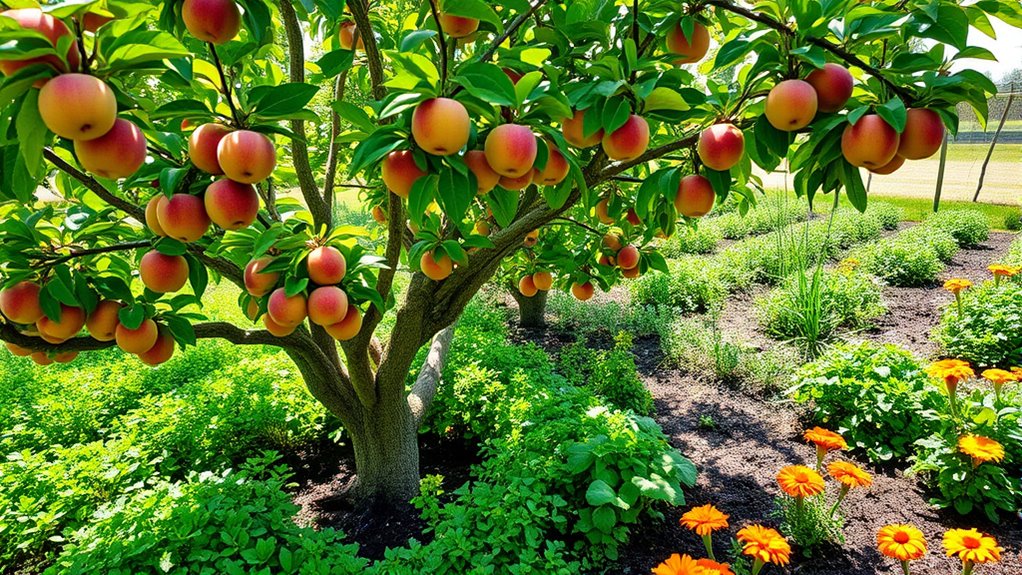
Companion planting can greatly enhance the growth of fruit trees by creating a thriving ecosystem that attracts pollinators and deters pests.
By strategically selecting companion plants, you can boost the health of your fruit trees and promote a vibrant garden.
Consider these benefits:
- Nitrogen-fixing plants enrich the soil, providing essential nutrients for enhanced growth.
- Pest repellents like marigolds or nasturtiums protect your trees from harmful insects while suppressing weeds.
- A diverse arrangement improves air circulation, reducing humidity and minimizing disease risk.
Sustainable Practices in Small Farm Fruit Production
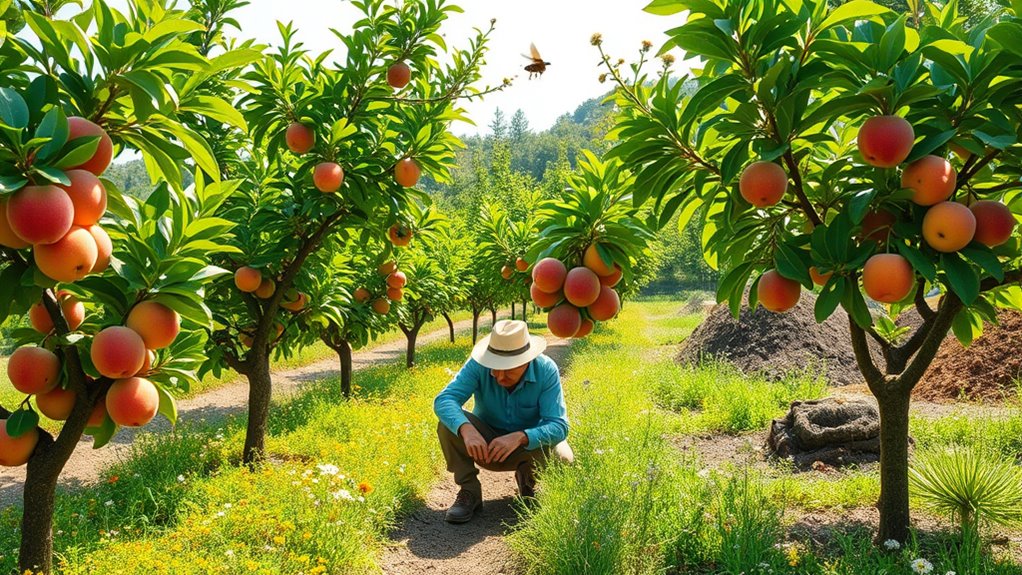
As you cultivate fruit trees on your small farm, embracing sustainable practices can greatly enhance your production and environmental impact.
Start by utilizing organic compost and native soil mixtures to improve soil fertility and structure, reducing the need for chemical fertilizers.
Implement companion planting with beneficial perennial plants, which can enhance biodiversity and naturally control pests.
Regular inspections and integrated pest management (IPM) help you identify and manage pest populations early, minimizing crop losses.
Underplanting with herbs and flowers not only attracts pollinators but also creates a symbiotic ecosystem that deters harmful pests.
Finally, adopting waste management practices, like composting fruit scraps, fosters a sustainable cycle of nutrient use, enriching your soil and supporting healthy fruit production. Additionally, ensure you have access to water sources to maintain your trees' hydration needs, especially during dry spells.
Frequently Asked Questions
What Are the Most Low Maintenance Fruit Trees?
If you're looking for low-maintenance fruit trees, consider dwarf varieties like Honeycrisp apples and Brown Turkey figs. They thrive in limited space and bear fruit quickly.
Plum trees are also great due to their adaptability and minimal care needs. Semi-dwarf peach trees, like Redhaven, provide sweet fruit without much effort.
Self-pollinating varieties, such as Shinseiki pears, simplify your garden setup. Just remember to prune regularly and water adequately for the best results!
Which Fruit Tree Is Most Profitable?
When considering which fruit tree is most profitable, you should look at various factors like market demand and growing conditions.
Apple trees often lead the pack, yielding up to 40,000 pounds per acre.
However, blueberries are also lucrative, with profits ranging from $5,000 to $10,000 per acre.
If you're in a suitable climate, avocado trees can bring in around $20,000 per acre, making them a solid choice for profitability.
Which Fruit Tree Is Best for a Small Garden?
If you're looking for the best fruit tree for a small garden, consider dwarf varieties like Honeycrisp apples or Redhaven peaches. They stay compact at 6-8 feet but yield full-sized fruit.
Self-pollinating options, such as Shinseiki pears or Brown Turkey figs, make it easier since you won't need multiple trees. Regular pruning helps keep them manageable, ensuring you can enjoy fresh fruit without sacrificing space.
Plus, container gardening lets you maximize your limited area!
What Is the Easiest Dwarf Fruit Tree to Grow?
When it comes to growing dwarf fruit trees, you can't go wrong with the Dwarf Apple Tree.
It's a breeze to care for, producing fruit in just 2-3 years.
If you're looking for something even easier, consider the Dwarf Pear or Cherry Trees, as they require minimal maintenance and fit perfectly in small spaces.
Just remember, with the right choice, you're planting the seeds for delicious homegrown fruit in no time!
Conclusion
To sum up, choosing the right fruit trees for your small farm can truly bear fruit in the long run. By selecting compact varieties and implementing sustainable practices, you'll maximize your harvest and create a thriving ecosystem. Remember, a little effort goes a long way—so don't hesitate to get your hands dirty! With the right care, you'll be well on your way to enjoying bountiful yields and a fruitful farming experience.

